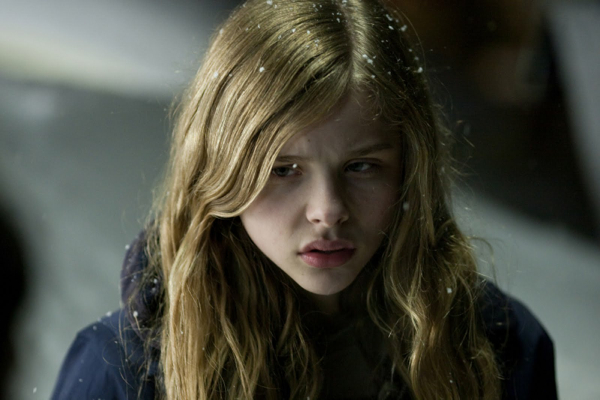Movie review by Greg Carlson
“Cloverfield” director Matt Reeves respectably re-shoots Tomas Alfredson’s 2008 “Let the Right One In,” the sharp adaptation of John Ajvide Lindqvist’s debut novel about the relationship between a bullied boy and the petite vampire who moves in next door. Despite the filmmaker’s claims to the contrary, the Americanized version, re-titled “Let Me In” at the expense of the Morrissey lyric, is slavishly faithful to the style, tone, and mood of the original Swedish article – which could be good or bad depending on one’s attitude about remakes in general and “Let the Right One In” in particular.
As Owen (formerly Oskar) and Abby (formerly Eli), actors Kodi Smit-McPhee and Chloe Moretz effectively navigate the sometimes subtle and tender emotional terrain traversed by their youthful characters, even if they do not improve on the performances of Kare Hedebrant and Lina Leandersson. The invaluable Richard Jenkins, who plays the pathetic blood-hunter misidentified by neighbors as the vampire’s father, elicits a disproportionate amount of sympathy in his limited screen time, especially given the gruesome nature of his vocation and his implied pedophilia (scrubbed from the movie but explored in detail in the novel). One wishes Reeves had spent more time exploring the character, if only to allow the audience the pleasure of Jenkins’s company for a longer duration.
Lindqvist has diplomatically praised both cinematic incarnations of his book, which makes a great deal of sense given that he wrote the adaptation upon which the movies are based (despite Reeves’s dubious “written for the screen” credit on “Let Me In”). Newcomers to the story who missed “Let the Right One In” are advised to see Alfredson’s film prior to “Let Me In,” and will notice a few key differences between the movies. Reeves’s biggest departure and most interesting alteration from “Let the Right One In” is the re-imagining of Father’s bungled attack in the locker room as a tense, automotive urban legend. Reeves also intersperses clips from Ronald Reagan’s March 1983 “Evil Empire” speech and envisions Owen’s perpetually obscured mother as a devout evangelical.
Thirsty fans hoping that Reeves might return to Lindqvist’s sizable tome rather than the author’s condensed script for the 2008 film will be disappointed. None of the novel’s significant subplots that were cut the first time appear in the American edition. The multiple narrative points of view, the group of adults affected by vampire attacks, Oskar/Owen’s sympathetic ally Tommy, Eli/Abby’s feeding encounter with the medicated old woman, and Hakan/Father’s resurrection and morgue escape are almost entirely absent. Lindqvist was wise to eliminate most of these elements the first time around, and Reeves would have been hard pressed to improve on “Let the Right One In” by squeezing in more plot.
The early 1980s setting, the dreariness of the working class, and the sober and pervasive sense of doom and desperation in Owen and Abby’s world contrast sharply with the glossy depiction of the Cullen clan’s wealth in the “Twilight” series and the hyper-sexualized vampire/human couplings of “True Blood.” Abby’s missing genitalia and gender ambiguity, more explicitly addressed in “Let the Right One In” than in “Let Me In,” as well as her struggle to understand Owen’s urges to go steady, position Lindqvist’s tale as a romantic bildungsroman that uses vampirism as a lens through which to examine adolescent confusion. In this capacity, “Let the Right One In” and “Let Me In” share intriguing variations within the surging vampire genre.
